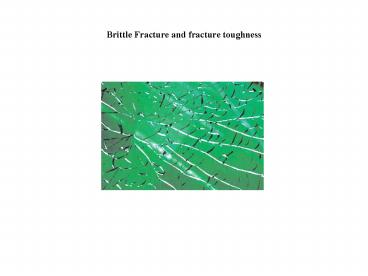Brittle Fracture and fracture toughness - PowerPoint PPT Presentation
1 / 28
Title:
Brittle Fracture and fracture toughness
Description:
Ductile fracture. Plasticity, shown in red, concentrates stress on inclusions that fracture ... If the material is ductile a plastic zone forms at the crack tip. ... – PowerPoint PPT presentation
Number of Views:1725
Avg rating:3.0/5.0
Title: Brittle Fracture and fracture toughness
1
Brittle Fracture and fracture toughness
2
- Tough and brittle behavior. The crack in the
tough material, shown in (b), does not propagate
when the sample is loaded that in the brittle
material propagates without general plasticity,
and thus at a stress less than the yield strength.
3
- Measures of fracture toughness (a) The tear
test. (b) The impact test. Both are used as
acceptance tests and for quality control, but
neither measures a true material property.
4
- Stress concentration at a crack. Lines of force
in a cracked body under load the local stress is
proportional to the number of lines per unit
length, increasing steeply as the crack tip is
approached. A crack is a long but very narrow
stress concentrator.
5
Note the stress shadow at the top. Max stress is
about 2x-3x the average stress away from the crack
6
Smaller notch, lower stresses so there is a
critical crack size for fracture
7
- Measuring fracture toughness, K1c. The compact
tension test is widely used, usually with a
groove cut along the sample to guide the growing
crack. In the Fracture Mechanics approach, the
expected strength of a material ?, is related to
the crack length and toughness, K1c
8
- The release of elastic energy when a crack
extends. In the Griffith theory, fracture
strength relates to fracture energy and the crack
size.
9
(No Transcript)
10
Fracture depends on existing cracks These may
grow from defects or form as a result of fatigue
after cyclic loading (vibration) Occurs when the
biggest crack in a part reaches the critical
length. Often the crack first grows slowly by
fatigue or corrosion. Griffith Theory of
fracture Strength ? E Elastic Modulus, c
crack length, ? is surface energy Comparing the
two theories, K1c (2E ?)!/2
11
In a brittle material, cracks may grow slowly in
cyclic fatigue and then lead to sudden failure
once they are long enough. If the same material
were ductile, the metal at the crack tip would
yield and blunt the crack so it stops
growing. Fatigue cracks at stress concentrations
are a big worry because they can be
unpredictable.
12
- A plastic zone forms at the crack tip where the
stress would otherwise exceed the yield strength
sy. Many plastics, like PMMA, craze at the crack
tip which opens up voids and absorbs energy.
13
- The transition from yield to fracture at the
critical crack length ccrit.
14
- A chart of fracture toughness Klc and modulus E.
The contours show the toughness, Gc.
15
- A chart of fracture toughness K1c and yield
strength sy. - The contours show the transition crack size,
ccrit.
16
Origins of fracture toughness Anything that
absorbs energy as the crack grows increases
toughness
17
- When new surface is created as here, atomic bonds
are broken, - requiring some fraction of the cohesive energy
between atoms , Hc.
18
- Cleavage fracture. The local stress rises as
1/?r towards the crack tip. If it exceeds that
required to break inter-atomic bonds (the ideal
strength) they separate, giving a cleavage
fracture. Very little energy is absorbed.
19
- Ductile fracture. Plasticity, shown in red,
concentrates stress on inclusions that fracture - or separate from the matrix, nucleating voids
that grow and link, ultimately causing fracture.
20
- If the material is ductile a plastic zone forms
at the crack tip. Within it voids nucleate, grow
and link, advancing the crack in a ductile mode,
absorbing energy in the process. This is brittle
fracture but with a large fracture surface energy.
21
- Chemical segregation can cause brittle
intergranular cracking.
22
- The strength and toughness of wrought and cast
aluminum alloys. Often toughness decreases as
hardness yield strength increase..
23
(No Transcript)
24
- The strength and toughness of polypropylene,
showing the effect of fillers, impact modifiers
and fibers. Generally fillers stiffen a polymer
but make it more brittle. Added rubber particles
or reduced crystallinity reduce stiffness but
increase toughness. Only long fibers (gt20
length/diameter) increase stiffness and
toughness, but they make it harder to process.
25
- Toughening by fibers. The pull-out force opposes
the opening of the crack. Much energy goes into
friction of pulling out the fibers.
26
There is much interest in making tougher
ceramics These are needed for engine components
pistons, turbines etc. By adding fibers By
choosing fibrous oxides or nitrides (silicon
nitride) By adding metal particles By adding
polymer layers Lanxide aluminum oxide sheets
grown by oxidation of a skin on molten aluminum
metal, expensive but toughened by aluminum drops
trapped in the ceramic.
27
Ceradyne Corp.
28
(No Transcript)

